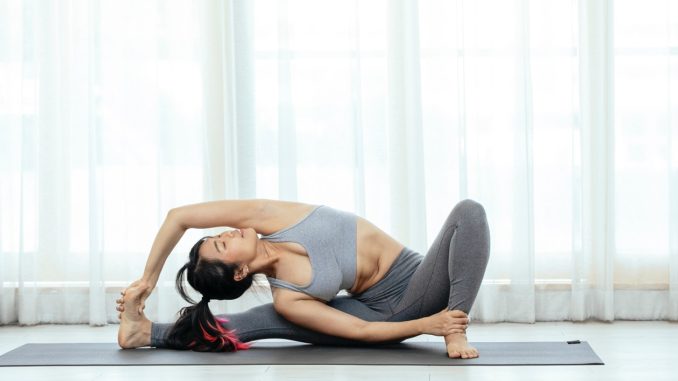
You may have heard about Hatha Yoga from a colleague or friend and want to know more about it. This yoga is among the popular styles, practiced since ancient times.
About Hatha Yoga
Hatha Yoga, traditionally is considered to be a catchall term used for any yoga type that pairs ‘asanas’ (poses) along with ‘pranayama’ (breathing techniques). It comprises of several popular yoga styles such as Iyengar, Vinyasa, restorative, ashtanga, etc. It is rather a slow-paced yoga that focuses more on appropriate body alignment.
Hatha yoga is a branch of yoga that focuses on physical postures (asanas), breathing techniques (pranayama), and meditation. It is a gentle and slow-paced practice that is suitable for people of all ages and fitness levels. Hatha yoga is often used as a form of stress relief and relaxation, and it has been shown to have numerous benefits for mental and physical health.
One of the primary benefits of hatha yoga is its ability to reduce stress. Stress is a common problem in modern life, and it can have a negative impact on both mental and physical health. Hatha yoga is a natural and effective way to reduce stress levels and improve overall well-being.
One way that hatha yoga reduces stress is by activating the relaxation response. The relaxation response is a state of deep relaxation that counteracts the effects of stress on the body. When we are stressed, our bodies release cortisol, a hormone that triggers the fight-or-flight response. This response prepares us to face a threat by increasing heart rate, blood pressure, and respiration. While this response is useful in short bursts, it can be harmful when activated over long periods of time.
Hatha yoga activates the relaxation response by slowing down the breath and heart rate, relaxing the muscles, and calming the mind. This reduces the production of cortisol and other stress hormones, and it promotes a sense of calm and relaxation. Regular practice of hatha yoga can help to reduce chronic stress and improve overall well-being.
Another way that hatha yoga reduces stress is by increasing mindfulness. Mindfulness is the practice of being present in the moment and fully engaged in the current experience. When we are mindful, we are less likely to worry about the future or dwell on the past, which can be a source of stress and anxiety.
Hatha yoga promotes mindfulness by encouraging us to focus on our breath and our body. During a hatha yoga practice, we are instructed to pay attention to the sensations in our body, the rhythm of our breath, and the present moment. This helps us to become more aware of our thoughts and feelings, and it can reduce the impact of stress on our mental and emotional well-being.
In addition to reducing stress, hatha yoga has many other benefits for mental health. For example, hatha yoga has been shown to improve mood, reduce symptoms of anxiety and depression, and increase feelings of well-being. Regular practice of hatha yoga can help to cultivate a sense of inner peace and happiness, which can have a positive impact on all areas of our lives.
Hatha yoga also has numerous benefits for physical health. One of the primary benefits of hatha yoga is its ability to improve flexibility and strength. The physical postures of hatha yoga stretch and tone the muscles, increase range of motion, and improve overall physical fitness.
In addition to improving flexibility and strength, hatha yoga has been shown to have numerous other physical benefits. For example, hatha yoga can improve cardiovascular health by lowering blood pressure and reducing the risk of heart disease. It can also improve respiratory function by increasing lung capacity and improving breathing efficiency.
Hatha yoga has also been shown to improve digestion, boost immune function, and reduce inflammation in the body. Regular practice of hatha yoga can help to promote overall health and well-being, and it can be a natural and effective way to prevent and manage many common health problems.
In conclusion, hatha yoga is a natural and effective way to reduce stress and improve overall health and well-being. Regular practice of hatha yoga can help to activate the relaxation response, increase mindfulness, improve mood, reduce symptoms of anxiety and depression, and promote physical fitness and overall health. If you are looking for a way to reduce stress and improve your mental and physical health, hatha yoga may be the perfect practice for you.
Health benefits derived
A few benefits obtained from performing Hatha Yoga poses include the following:
- Better balance: Five month studies conducted on 34 men in 2014 performing such yoga poses were found to enjoy better postural control. Hence, training hatha yoga helps improve body balance.
- Reduced anxiety: A 2016-based meta-analysis involving 17 studies offers support for hatha. It states this yoga to be a wonderful cure to anxiety problems.
- Fitness improvements: Studies conducted on adults in 2015 showed that practicing hatha yoga for 12 weeks offered positive effects. This was on numerous fitness components like muscle flexibility, endurance, strength as well as cardio endurance.
This form of yoga is also found to offer other benefits like cure pain, reduce blood pressure, BMI and menopausal symptoms. It also improves mental health and manages chronic diseases. Regular practice allows you to become quite capable and movable. You become strong and will have confidence to do everything without tiring, something that seemed impossible before starting practice.
Hatha yoga class
The format specified for the yoga session is likely to vary from one teacher to the other and class. Generally, classes start with certain ‘centering exercises’. It can be on your back or in seated position, involving a breathing exercise, simple guided meditation or moment of silence.
The expert will then provide guidance to practice series of movements like folding, bending, twisting, etc. to develop ‘peak pose’. On achieving this pose, perform series of movements as it helps counterbalance a few previous poses. This, in turn, allows you to feel ‘well-balanced’.
Alternatively, the class might incorporate diverse postures instead of focusing on ‘peak pose’. It may include twists, balance poses, reclining poses, standing poses, etc.
This form of yoga lays emphasis on ‘breathwork’ that is timed to movements, usually, at a much slower pace. The classes may include chanting and meditation. It is not mandatory to practice all poses or hold them for long. You may break poses early or opt out completely to stand/sit. Also, you are allowed to take breaks in-between if desired.
